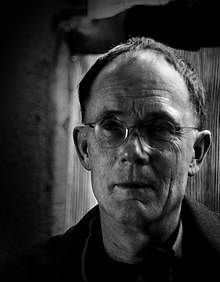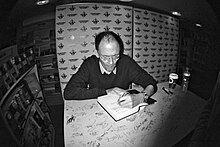William Gibson
William Gibson | |
|---|---|
 Portrait of Gibson in Paris during an interview on his 60th birthday, March 17, 2008 | |
| Born | March 17, 1948 Conway, South Carolina |
| Occupation | Novelist |
| Citizenship | United States, Canada |
| Period | 1977– |
| Genre | Speculative fiction |
| Literary movement | Cyberpunk, steampunk, postcyberpunk |
| Notable works | Neuromancer (novel, 1984) |
| Notable awards | Nebula, Hugo, Philip K. Dick, Ditmar, Seiun, Prix Aurora |
| Website | |
| williamgibsonbooks | |
William Gibson (born March 17, 1948) is a writer. He writes science fiction books. He is one of the most important people in the part of science fiction called cyberpunk. His most famous book is Neuromancer.
Early life
Childhood, moving around, and adolescence
William Ford Gibson was born in Conway, South Carolina on the Atlantic coast. He spent most of his childhood in Wytheville, Virginia. Whytheville is a small town in the Appalachians. His parents had been born and raised there.[1][2]
Gibson was shy and awkward as a teenager. He grew up in a place and time where most people thought and acted alike. This was a problem for him.[3] He chose not to believe in religion. He read science fiction and writers such as William S. Burroughs and Henry Miller.[4][5] Gibson was not doing well in school and his mother was frustrated. She threatened to send him to a boarding school. She was very surprised when he liked this idea very much.[6]
Avoiding the military, leaving home, and counterculture
Gibson's mother died when he was eighteen years old. He left school and did not graduate. He traveled a lot. He became very interested in the counterculture. He left the United States and moved to Canada during the Vietnam War draft.
After graduation, early writing, and the beginning of cyberpunk
Gibson finished a graduate degree about science fiction. He stopped writing for one year. He did not like the trends he saw in SF. He was more interested in punk rock. He met other writers such as Bruce Sterling, Lewis Shiner, and Rudy Rucker. These writers became the important members of the cyberpunk movement in SF.
Literary career
Early short fiction
Gibson's first published short story was "Fragments of a Hologram Rose" (1977). He wrote other short stories for magazines such as Omni. He was often compared to J. G. Ballard. Some of the characters and places in his short stories are also in his Sprawl novels.
Neuromancer
- The sky above the port was the color of television, tuned to a dead channel.
- --the first sentence of Neuromancer (1984)
Terry Carr asked Gibson to write Neuromancer for the second series of Ace Science Fiction Specials. The purpose of the series was to give attention to first-time novelists.[7]
The Sprawl trilogy, The Difference Engine, and the Bridge trilogy
Neuromancer was a success and Gibson kept writing SF. The Sprawl trilogy continued the story of Neuromancer, even though Gibson did not plan to write any sequels. Then he explored other ideas. The Difference Engine was alternate history. In The Bridge trilogy, Gibson wrote about new problems. He paid less attention to large corporations or artificial intelligence. He wrote more about mass media and celebrity.
Blue Ant
Gibson's novels Pattern Recognition (2003), Spook Country (2007) and Zero History (2010) happen in the same contemporary universe — "more or less the same one we live in now"[8]

Other kinds of writing
Working with other writers
He has written short stories and novels with others, especially other cyberpunk authors John Shirley and Bruce Sterling.
Film
There have been many attempts to make films based on Gibson's writing. Most of these have never been completed.
Shows, poetry, music, and performance art
Gibson has written poems too. He has also worked with artists, architects, and musicians.
In 1990, Gibson was part of an exhibit at the San Francisco Museum of Modern Art called "Visionary San Francisco".[9] He wrote a short story, "Skinner's Room", that took place in San Francisco. In the story, the San Francisco – Oakland Bay Bridge was closed and became a community for homeless people. Architects Ming Fung and Craig Hodgetts were interested in the story and imagined a future San Francisco. Their idea of the future showed rich people living in high-tech towers above a city that was falling apart.[10] Gibson was part of the architects' exhibit. Visitors could watch a video of him discussing the future and reading from the story "Skinner's Room".[11] Another version of the short story appeared a year later in Omni magazine.[12]
In 1993, Gibson wrote some lyrics for the album Technodon by the Japanese group Yellow Magic Orchestra. He was the vocalist on the track "Hi-Tech Hippies".[11][13] He wrote lyrics to the track "Dog Star Girl" on Deborah Harry's Debravation.[14]
Essays and short nonfiction
Gibson sometimes writes nonfiction for newspapers or magazines. He has written essays, opinion-editorials, and commentary for publications such as: Wired, The New York Times, The Observer, Addicted to Noise, New York Times Magazine, Rolling Stone, and Details Magazine.
Influence and recognition
Ideas about cities
In his fiction and non-fiction, Gibson often writes about cities. He thinks many cities are losing variety. One way of describing this is "Disneylanding".[15]
Importance in the culture
Many writers believe that Gibson helped science fiction become cool.
Important ideas and seeing the future
His work seemed did not just predict the future of technology such as the World Wide Web. The ideas in his books were important to the people who created Internet technology.
Some writing by Gibson
- Nonfiction
References
- ↑ Gibson, William (2002-11-06). "Since 1948". Archived from the original on 2007-11-20. Retrieved 2007-11-04.
- ↑ Adams, Tim; Emily Stokes and James Flint (2007-08-12). "Space to think". Books by genre. London: The Observer. Retrieved 2007-10-26.
- ↑ Gibson, William (November 12, 2008). "Sci-fi special: William Gibson". New Scientist. Retrieved 2008-11-17.
- ↑ Marshall, John (2003-02-06). "William Gibson's new novel asks, is the truth stranger than science fiction today?". Books. Seattle Post-Intelligencer. Retrieved 2007-11-03.
- ↑ Mark Neale (director), William Gibson (subject) (2000). No Maps for These Territories (Documentary). Docurama.
- ↑ Sale, Jonathan (June 19, 2003). "Passed/Failed: William Gibson, novelist and scriptwriter". The Independent. London: Independent News & Media. Retrieved 2009-03-12.[permanent dead link]
- ↑ Gibson, William (2003-09-04). "Neuromancer: The Timeline". Archived from the original on 2006-12-30. Retrieved 2007-11-26.
- ↑ Chang, Angela (January 10, 2007). "Q&A: William Gibson". PC Magazine. 26 (3): 19. Archived from the original on May 1, 2009. Retrieved February 29, 2020.
- ↑ Polledri, Paolo (1990). Visionary San Francisco. Munich: Prestal. ISBN 3-7913-1060-7. OCLC 22115872.
- ↑ Goldberger, Paul (1990-08-12). "In San Francisco, A Good Idea Falls With a Thud". The New York Times. Retrieved 2007-11-06.
- ↑ 11.0 11.1 S. Page. "William Gibson Bibliography / Mediagraphy". Retrieved 2008-02-09.
- ↑ Gibson, William (November 1991). "Skinner's Room". Omni.
- ↑ "Yellow Magic Orchestra - Technodon". Discogs. Retrieved 2011-07-29.
- ↑ Pener, Degen (1993-08-22). "EGOS & IDS; Deborah Harry Is Low-Key -- And Unblond". The New York Times. Retrieved 2011-07-29.
- ↑ Shattuck, Aaron; Gary Stix (August 19, 2011). "Cities in Fact and Fiction: An Interview with William Gibson". Scientific American, a Division of Nature America, Inc. Retrieved 2011-08-17.
Other websites